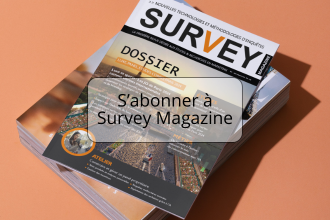More and more people in Europe and in the world are sharing the issue of the nature and environment protection, of the ecological balances respect and of the research on a more sustainable development. These civic concerns are also presents in the companies even if most of them seem to broach the ecological subject as a good communication vector in order to answer to a consumer demand rather than broaching it as an essential value that daily should guide the strategic choices and the management modes of the company. The approach that consists in exploiting in a fallacious way the environment issue is called “the green-washing”. In a European survey, led by the Coleman Parkes Research Institute, about 52% of the European Marketing Directors do not think that their company has a clear aim in reducing the impact of its marketing activities on the environment. One quart of the companies tries to measure this impact and less than one over ten announced precise aims concerning this subject. The marketing surveys activity (the one in which we first are interested is the Survey-Magazine) takes part of the most guzzler fields in all kinds of resources. It often involves a multiplication of supports, of travels and of equipment. It plays along useful optimizations for the environment respect. The next slides will introduce you to the concrete actions in order to get to the reduction of the ecological imprint and to the respect of the environment.
Optimizing your questionnaires on paper
Let us first approach the printed questionnaire case, even if today it does not have the same importance than before. Actually, with the increase of surveys by phone in the 1990s and then the boom of the web surveys in the 2000s, the questionnaire on paper has been relegated either to punctual applications in a small volume (seminaries evaluation, event questionnaires…) or to huge operations with hundreds of thousands of questionnaires broadcasted on the field and then typed with the optical or scan reading (satisfaction surveys on each store in an area…). In the paper field, there is a huge quantity of common beliefs. Actually, its production does not decimate our forest. The used paper pulp in France essentially comes from cut woods that are cut in order to maintain the forest (70%) and from falls coming from sawmills. Nowadays, our forests occupy 15,5 millions of hectares while they only represented 11 millions of hectares in the half past century and 9 million 150 years ago. However, it exists a pollution problem resulting from the production methods. Actually, the cellulose extraction that is essential to the paper whitening, requires a lot of energy and huge quantity of water (60 liters/kilogram of paper). This water is extracted from the streams and is rejected at the end of the production process, with a certain amount of toxic stuffs such as dioxin or chlorinated furans. Huge efforts have already been made in order to reduce the quantity of the substances that stay in substantial quantities. The quantity reduction of used paper is so an ecological challenge, for this reason and not for the protections of our forests. In order to minimalize the impact of surveys on paper, here are some rules that are useful to know:
1. Using less paper thanks to a better layout of your questionnaires. Avoiding the big empty areas by disposing questions on several rows. Using a reasonable letter size (10) for a good readability and favor the condense fonts (such as Arial Narrow), especially if your questions and answers wordings are longs.
2. Also using the verso in your questionnaires.
3. Reducing the tint areas in order to not overload the document with the ink.
4. Favoring the Made in France paper that both respects strict laws and needs less energy to get to you.
5. Using recycled paper when you can. It has a better energy appraisal even if its footprint is far from the neutrality.
6. Selecting paper with a normal basis weight (80 or 90 grams) and asking the respondent people to not answer with felt pens.
7. Using standard formats such as A5, A4 or A3, that are adapted to standard pads of the publishers equipment and that reduce the waste.
8. Selecting publishers that have the Imprim’Vert label that is actually known for its limitation of toxic products and for its reduction of rubbish and the impact of their elimination.
9. Optimizing the distribution of you supports on the field and their return, by avoiding for example partial sendings, dual carriageway shipments, the sending of inadequate or divided quantities…
10. Eliminating in an adequate way the questionnaires after their typing and treatment.
Saving energy on the field
The administering phase of the face-to-face questionnaire is one of the most important sources in the reduction of the ecological impact of surveys, whether it is a survey on paper or a survey computerizing the data collection (CAPI on a pocket-pc or laptop; CAMI on mobile phones or digital tablets…). Here are some simple rules that enable to reduce the environmental impact and to generate still likable reduction in the field budget at the same time:
1. The first rule consists in enabling the researchers to avoid important travels by trying to make them intervene in the closest sectors from their departure points (office or home) and by putting them in the less unlinked areas. At the same time, we must try to avoid useless go and back by grouping surveys according the geographical proximity criterion, which is better than other criteria.
2. It is needed that service providers work with established researchers’ networks in the areas where the researchers will intervene rather than make the researchers travel.
3. For the researchers’ travels, it is needed to favor the public transports rather than the car. It can be encouraged by the refund politic, by excluding the kilometric defray except when it is essential.
4. Briefings for researchers can be distantly made with meeting tools on the web such as GoToMeeting from Citrix, WebEx from Cisco, Lotus Sametime from IBM or Acrobat Connect from Adobe. The subscription cost to this kind of service is about €25 per month for an unlimited number of meetings with as many participants as you want. If you are interested in this you can consult the comparison of the main market tools, which you can find on the following link: www.webconferencing-test.com.
5. Finally, you can organize yourself in order to directly online typing the surveys rather than make them travel with paper and retyping them. This solution enables to faster obtain results, without transport and need of retyping. You can make it with some tools such Net-Survey from Soft Concept.
Develop online survey
The online survey imposed itself few years ago by being the most simple,
the faster and the cheaper way to realize surveys on the field. Software
such as Net-Survey have made the realization and the spread of simple or
sophisticated questionnaires easier, by replacing the classical way such
as paper or CATI (surveys by phone).
Additionally to the quality that made its success, the online survey
seems to be in harmony with the environmental concern. Some people
contest it by saying that the consumption of the hosting servers of
online surveys in addition to the one of the respondent computers causes
huge energy spending. A Gartner survey agrees with this opinion because
it shows that web and new technologies produce 2% of the global CO2
emissions, as much as the aeronautic industry. Of course, online surveys
represent a small part of it. But this is not the reason to ignore
optimizations that we can bring for that expending administration
mode:
1. Optimize your online surveys by taking advantage of the specific ergonomics of this administration way. Actually, many web questionnaires copy the paper questionnaires or questionnaires by phone and propose long pages to read such for the paper questionnaires or conversely, such as for the questionnaires by phone, pages with only one question. In the first case, the respondent person loses time by reading the pages. In the second one, she loses time by clicking after each answer in order to get to the next page. Software such as Net-Survey on one hand enables to place several questions on the same page, in a compact way and thought to make the answer selection easier. In another hand, it enables to manage contextual masking and displays that only propose on the screen or the following pages, the questions inferred by the last answers. The web questionnaire is faster to fill. Our file “Online surveys: How to optimize your answers rate?” give you 10 essential advices for optimized web questionnaires.
2. Choose CAWI technologies that do not need any installation or downloading from the respondents’ side. The systems based on Java or Flash applets can cause utilization issues and losses of time and energy. In addition to the standard and easy to access way, the HTML questionnaires are faster and need fewer resources than others.
3. Do not encourage you respondents to print the survey support to fill it on a paper before retyping it on Internet. If it is not essential, do not propose a recap at the end of the survey. Some people would be tempted to edit in order to keep a track of their answers. Avoid adding PDF documents to your questionnaires by directly integrating necessary information in the online questionnaire.
4. Choose a web provider that cares about the environmental issues. The “Green Hosting” hosting notion is widely spread off. Servers centers that propose this kind of approach share the servers among consumers with a reduced consumption and care about their rubbish recycling and the use of renewable energy sources. In France, the Green Hosting pioneer is Ikoula.
Be interested in new mobile surveys
A new data collection solution is developing on the market: the mobile
survey or CAMI (Computer Assisted Mobile Interview). The CAMI arriving
make us remember about the web surveys boom (CAWI) few years ago.
This new surveys method in face-to-face exploits the impressive
potential of smartphones and digital tablets and open new perspectives
for the data collection on the field. Conversely to the CAPI that works
on Pocket-PC (these devices are not produced by the known producers
anymore but only by some south-corean outsourcers), the CAMI makes the
data transmission easier thanks to 3G connected or wifi connected
devices. We made an entire file about this new survey process. You can
find it here.
On the ecological view, CAMI uses less paper, less transport and less
energy. Of course, all materials have an ecological footprint only for
its production and its charging. But the growing field of digital
tablets and smartphones should quickly give birth to new ecological
devices, such as some mobile phones: Sony Ericson Elm, produced with
recycled material, LG Pop, that has a solar panel in the back of the
battery in order to charge it or the Sony Ericson Hazel that has a low
consumption charger…
Act on the content side
For the moment we evoked possible ecological efforts concerning
organizational modalities of the surveys. But surveys are not a banal
activity. They tend to orientate the strategies of the companies and to
enable them to propose products linked to the demands of the public.
This status of help to decision tool can enable to surveys professional
people to get further than the simple functioning economies in order to
be proactive in the ecological domain. They can act on the surveys
content side in order to implement questions in it that enable to
highlight the growing ecological expectations of the consumers and to
identify environment improvement trails in the production, the
commercialization and the communication modes of the company. This
approach is not really common. We begin to find some consumers that are
annoyed (here is an example from a forum: “why does the gloominess of
taking the carton or the plastic off of the products never appear in
their f****** marketing surveys?”). It is true that many surveys try to
test the impact and the visual attractiveness of a packaging and few of
them try to evaluate the consumer interest for a lite packaging. Whether
surveys professional people would more concentrate on the way to
highlight the environmental concerns and on the consumer interest for
more ecological alternatives, they could efficiently help the
environment protection and the deciders positioning for more ecological
approaches.
Going further and further
Empirical approaches of a good ecological will already are a good
starting base for people who want to act in their professional
environment. One thing: people can always do something useful, even when
they are not fully aware of the effective impact of their initiatives.
Because the complexity of this field does not always enable to
understand the whole problem.
Other activity sectors tried to clarify the impact of these different
kinds of actions on the environment. In the advertisement field, a tool
called “Ecoadvertisement” was implemented by Price Waterhouse and Havas
Media in collaboration with Ademe and LVMH. This tool enables to measure
the environmental performance and to evaluate the positive and negative
impacts of an advertisement campaign. Paying an annual contribution, the
announcers can fill a grill that describes the chosen supports for the
campaign and the engaged means and obtain the precise measurement of the
generated greenhouse gases emission, the used resources or the rubbish
resulting from their ad campaign. Before handle such a tool in the
surveys field, everybody can act in their way and find good ideas such
as EURO-VOTE (first responsible marketing surveys and online opinion
institute) that is engaged in the payment of its respondents not
directly but by transferring 10% of its turnover each month in order to
support the projects that are responsible of their choices.














